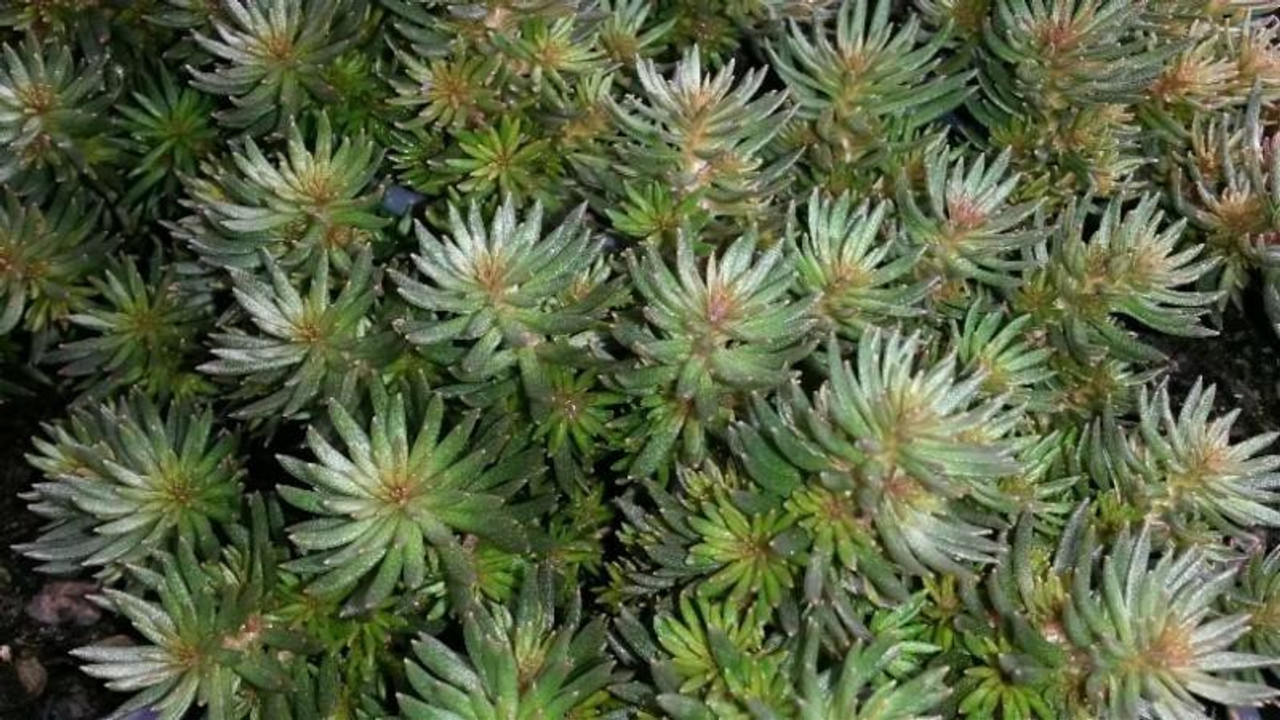Product Description
Sedum hakonese 'Chocolate Ball' - Ten (10) plants in 4.5-inch containers per flat (or tray).
Sedum hakonese 'Chocolate Ball' is a unique and attractive succulent that forms a low, spreading mat of chocolate-brown foliage. It is a wonderful addition to rock gardens, containers, and mixed borders, adding a touch of rich color and texture.
- Foliage: The needle-like, succulent leaves are a deep bronze to chocolate-brown color, creating a striking contrast with other plants. The foliage forms a dense, mat-like groundcover that remains attractive throughout the growing season.
- Flowers: In late summer to early fall, it produces clusters of small, star-shaped, yellow flowers that rise above the foliage. The flowers add a cheerful touch and attract pollinators like bees and butterflies.
- Growth Habit: It has a spreading, mat-forming habit, typically reaching 2-4 inches tall and spreading 6-12 inches wide. It spreads slowly, making it a well-behaved groundcover.
- Hardiness: It's hardy in USDA zones 4-9, tolerating a range of temperatures and conditions.
- Shade Tolerance: Unlike many Sedum varieties that prefer full sun, 'Chocolate Ball' thrives in light to partial shade, making it a versatile choice for gardens with some shade.
- Low Maintenance: Once established, it is very low-maintenance and drought-tolerant.
Growing Conditions:
- Sunlight: It prefers light to partial shade. Avoid full sun, especially in hot climates, as it can scorch the foliage.
- Soil: It prefers well-drained soil and tolerates poor, sandy, or rocky soils. It dislikes wet or poorly drained conditions.
- Moisture: It is drought-tolerant once established and prefers infrequent watering. Allow the soil to dry completely between waterings.
Uses in the Landscape:
- Rock Gardens: Its drought tolerance and unique foliage color make it a standout in rock gardens.
- Containers: It thrives in containers, adding texture and interest to patios and decks.
- Groundcover: When planted en masse, it can function as a colorful and textural groundcover.
- Borders and Edging: It provides a lovely contrast to other plants in borders and edges.
- Mixed Plantings: It combines well with other shade-loving succulents and perennials in mixed plantings.
Additional Tips:
- Pruning: It can be pruned lightly to maintain its shape or control its spread.
- Propagation: It is easy to propagate by division or stem cuttings.
- Deer and Rabbit Resistance: It is generally deer and rabbit resistant.
- Overwatering: Avoid overwatering, as this can lead to root rot.
Overall, Sedum hakonese 'Chocolate Ball' is a unique and versatile succulent that adds a touch of rich color and texture to gardens and landscapes. Its shade tolerance, drought resistance, and low-maintenance nature make it a popular choice for gardeners seeking an easy-care plant that thrives in a variety of conditions.
Ten (10) plants in 4.5-inch containers per flat (or tray).
Other Details
The most important part of the plant is its root system. Healthy roots are the foundation of a healthy, vibrant plant. The type of plug container used is based on the specific needs of the plants. Perennials offered as bare root traditionally perform better when planted as bare root.Planted in a specialized mix, potted plants have well established root systems. Top growth stage will vary depending on the current life cycle and time of year when shipped. In Winter and early Spring dormant plants may be shipped. Dormant plants may be planted right away, even before the last frost date.
Most bare root varieties are field grown for at least one season, though Hemerocallis and Hosta are grown for two seasons. The bulk of the soil is removed during the harvesting process and the tops of most varieties are trimmed back to the crown. They are graded, packed in shredded aspen or sphagnum moss and stored in freezers until ready to be shipped.
See our Container Sizes and Bare Root Perennials pages for more information.
Plant information and care is provided in the Overview section, Plant Genus Page and general information is provided in the Planting Care & Guides. Additional questions can be asked on each Plant page.
Plant Spacing: Using the maximum mature spread or width of a plant to guide spacing, ensures space to grow to full size. To fill an area sooner, plant them closer together. Just remember, future thinning or transplanting may be needed.
Water: Keep a close eye on newly planted perennials, especially throughout the first growing year. Most early plant loss is due to too much or too little water!





